
February 2017 Newsletter

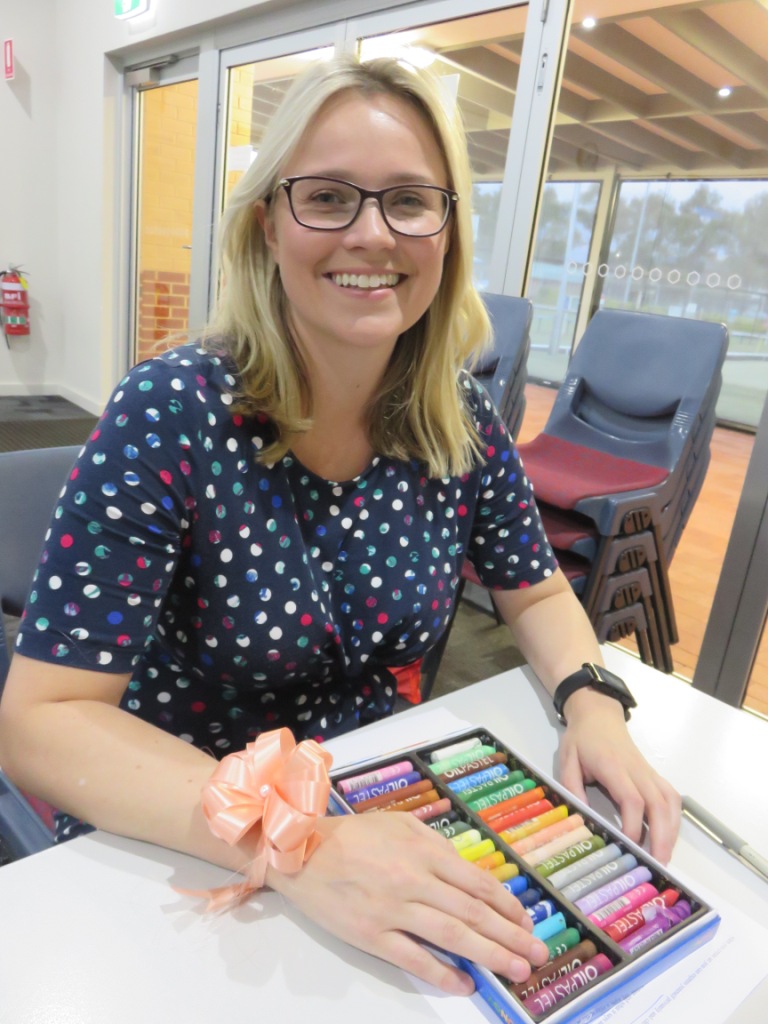
Hello, I’m Lauren Amos – welcome to the February Creative Catalyst newsletter.
Creative Catalyst Art Therapy and Consulting offers art therapy to individuals and groups, and facilitates creative workshops for process improvement and cultural change within organisations.
In this newsletter you’ll find information on online art therapy and workshops to suit group needs.
Online Art Therapy Launched
 After practising and refining the process with clients around Australia and the world, online art therapy is now available.
After practising and refining the process with clients around Australia and the world, online art therapy is now available.
If you’re outside or Perth of can’t get to the studio, online art therapy is a way to get creative and work through those blocks from the comfort of your own home. Sessions are available across time zones, so if you know someone overseas who might benefit from art therapy feel free to share this with them.
Sessions are 1.5 hours giving you enough time to choose a goal for the session, make art, reflect and discover insights and creatively explore how to achieve your goal. Clients have had success in one session in topics ranging from finding direction (such as in life and career) or visualising and clearing the path towards their personal goals. Even without a clear objective for the session, the art has a way of uncovering what’s really on your mind that you need to work on.
You also don’t need to have a fancy array of art materials to use. Of course it’s nice to have a choice but clients have still gained deep insights from scribbles and stick figures using pencils, pens and whatever can be found on their desks!
More information on the process is on the website, contact if you have more questions or you would like to book a session.
“I’d recommend it to people that are open to trying new things and exploring different ways to tackle a problem that they have ruminated on for long enough (or too long). It helps people to get past that “sticky” point and get beneath any unintentional mental blocks in the process.“ – Skype client
Mindfulness Art Therapy: Messages from the Body
The activity can be adapted to suit the needs of the group:
- Demonstrate art therapy for professional development education
- A non-stigmatising way to initiate conversations around mental health, stress and coping in the workplace
- A refreshing team building exercise
Mindfulness and art therapy activities have been run with diverse groups including:
“Amazing experience, really cool and incredible. It was really an important thing to do to just stop and do this process. Eye opening” – Mindfulness art therapy participant, Spacecubed
“Good exercise that helps visualise how our body is feeling, what signals we receive, help identify the issues and find solutions to fix them. I felt very comfortable sharing my feelings with Lauren and other people in the room.” – Mindfulness art therapy participant, Spacecubed
Check out the guided mindfulness meditation that I recorded to go with the activity.
Creative Catalyst is available to run workshops with private or organisational groups, contact for more information.
Perth Creative Art Therapy Group
The meetup group continues for 2017, in February covering the topics:
- Clearing money blocks
- Motivation
- Reframing
“The art therapy group today provided some insightful prompts that shone a light on my own assumptions and perceptions, as well as on the perceptions we often share through the contributions from other group members. The session was calming, thought-provoking and thoroughly enjoyable. Thank you!” – workshop participant
Upcoming Events
- 6th March, Coping with Emotions
- 12th March, TBA
- 20th March, Coping with Emotions
- 26th March, TBA
After opening the Mount Lawley studio in October, it’s exciting to now offer online services to reach the people of Perth and beyond.
Speaking of the online world, you can also keep in touch with Creative Catalyst via Instagram, the Facebook page and closed Perth Creative Art Therapy Facebook Group.
Wherever you are, I hope your year is humming along brilliantly.
Lauren Amos
January 2017 Newsletter


Hello, I’m Lauren Amos – welcome to the January Creative Catalyst newsletter.
Creative Catalyst Art Therapy and Consulting offers art therapy to individuals and groups, and facilitates creative workshops for process improvement and cultural change within organisations.
In this newsletter you’ll find information on public workshops and online art therapy.
Art Therapy for Pain: Applecross Physio Visit
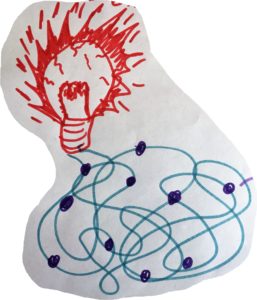
Pain Alarm
Art therapy is used to cope with emotional pain, but what about physical pain?
This was a question asked by Eddie Tikoft at LifeCare Applecross Physiotherapy. It turns out there is a growing body of research into the use of art therapy for chronic pain. As an outlet or distraction from the pain experience, to cope with the psychological impacts of a chronic condition as well as developing self-awareness around pain triggers to improve self-management.
In January I visited the team of physiotherapists, Pilates instructors and massage therapists to demonstrate art therapy, taking over the consulting area with paper laid out over massage tables as we all drew pictures with oil pastels. The art was used to represent how we were feeling, physically and emotionally, and it was insightful to see the shared experiences among the team (it seems this type of work can be hard on your feet all day!).
The team came away with a greater appreciation of how art therapy worked, I learned a lot about how pain was managed from the physical side and we discuss how a combined approach can help the whole person.
Creative Catalyst is open to educating other organisations on how creative approaches can complement their treatments.
Online Art Therapy via Skype
 One thing I love about opening the Mount Lawley studio is the array of art materials that I can keep for us to play with. But I realise not everyone can make it down for a session in person, maybe you live far away, you’re on a mine site or you are not able to travel.
One thing I love about opening the Mount Lawley studio is the array of art materials that I can keep for us to play with. But I realise not everyone can make it down for a session in person, maybe you live far away, you’re on a mine site or you are not able to travel.When I first heard about art therapy over the internet I was sceptical. Wouldn’t it be a little awkward? How does the art making work? Would it be as effective?
But I had a go as a client as part of my training and found the experience just as powerful as being in the room. I felt connected to the therapist even through the video and I was comfortable working through sensitive topics.
Through January I had many Skype (video chat) based sessions with clients all around Australia and overseas to make sure that the process (and internet connections) worked for everyone. After taking aboard some useful feedback to improve the process (timezones are now handled easily by the booking system) I will be launching online art therapy in February.
Signup to hear more about online art therapy when it launches.
“I really enjoyed the whole process. Having had therapy in the past, I was surprised at how quickly drawing was able to open up some pretty deep patterns in my life. It feels like a fast track way of uncovering layers.” – Skype client
Perth Creative Art Therapy Group
The meetup group is back for 2017 after a few weeks break. January saw an influx of new members interested in starting the new year with creativity.
“First time in a very long time that I have painted. I enjoyed it very much – dealing with emotions from past/present can be difficult and it has definitely helped me with dealing with some personal issues. Thanks.“ – workshop participant
January Events

Perth Creative Art Therapy Group:
Sundays: Letting go, New year new vision
Mondays: Coping with Emotions
Upcoming Events
|
After returning refreshed from holidays, it’s been exciting to pick up momentum again in January and to start planning for the next 12 months.
I hope your year is off to a wonderful start,
Lauren Amos
Messages from the Body: Mindfulness Art Therapy

How are you feeling today?
We don’t always get the chance to check in with how we are going.
Too busy getting on with the job, getting things done, staying focused. Or being stuck in our heads, wonderings about the future, the feelings of other people. It’s important to bring our attention to our bodies occasionally, to make sure we are giving them what they need to support us in achieving our goals.
Mindfulness is a practice of focused attention, a skill that helps us cope with distractions by developing the ability to stay present in the moment.
The body scan is a mindfulness technique that directs attention to the internal sensation of the body, listening and accepting the feelings that we experience.
The idea of sitting down and noticing what you feel inside your body sounds simple, but it can be quite hard. Thoughts keep popping into your head, distracting feelings that you’d rather avoid pop up. And if you’re not used to tuning into feelings inside it can be a challenge to identify what sensations you are having. Listening to a guided mindfulness script can help keep you on track as you follow along with the instructions.
I combined the body scan mindfulness with art therapy to help understand what my body is experiencing, and what it needs.
A while ago I was having a rough week, lots of little aches and pains in my body, a migraine, niggling signals that something wasn’t right but I didn’t know what it was. So I sat myself down to do some mindfulness art therapy to figure out what was going on and sort it out.
ARTLAB
AIM
To find out what my body needs
MATERIALS
A large sheet of paper (A2) you want enough space to capture the details of what you feel through the body.
Crayons, any easy to use set of colours is fine.
METHOD
Find a comfortable place free from interruptions.
Listen to a guided mindfulness body scan, there are many free apps such as Calm, which enables you to choose the length (5 to 10 minutes is recommended for people new to mindfulness). Or, I recorded my own guided mindfulness specifically for this activity which you can listen to below.
Turn the feelings you noticed during the mindfulness activity into a picture, a map of the feelings in your body.
RESULTS
Can you tell how I was feeling from this picture?
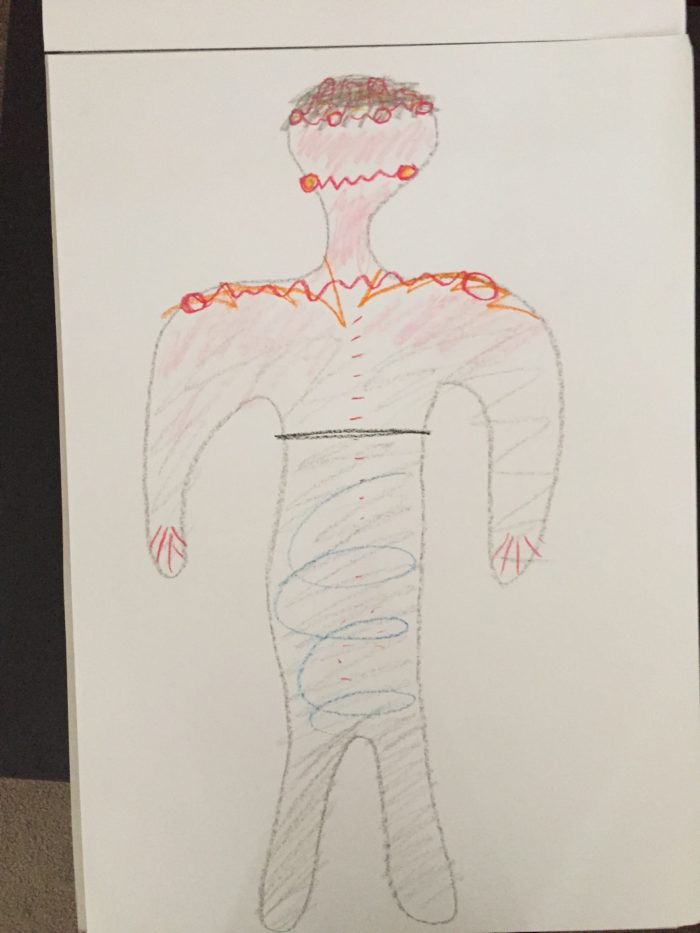
DISCUSSION
The body scan mindfulness had a soothing effect as if listening to my body meant it didn’t need to scream at me any more to get my attention.
The major focus of the picture are the tension lines around my neck, shoulders and jaw. I wasn’t able to notice much from the rest of my body because they were getting all the attention.
I took a photo of the picture and booked into a massage therapist, asking her to help fix this problem area. Representing what feelings I had inside allowed me to communicate my needs to someone else.
As well as taking care of the symptoms I reflected upon what had caused these feelings to arise in the first place. At the time I was preparing for a long overseas trip. I was very busy, running around trying to do all the things before I went away, putting a lot of pressure on myself. I reviewed my to-do list and reduced it, removing items that would be too hard to get done properly now and were best left until I returned from my trip.
By linking my body sensations to what was happening in my world, I could change what I was doing to better look after myself.
CONCLUSION
Combining the body scan mindfulness with art therapy was effective in allowing me to hear what my body needed, and think creatively about how I could fix it for myself.
Try this for yourself and share your insights.
Reflect
- What message does my body have for me?
- What could I give myself? Add this to the picture and notice if it changes the feeling in the picture
Online Art Therapy Launched
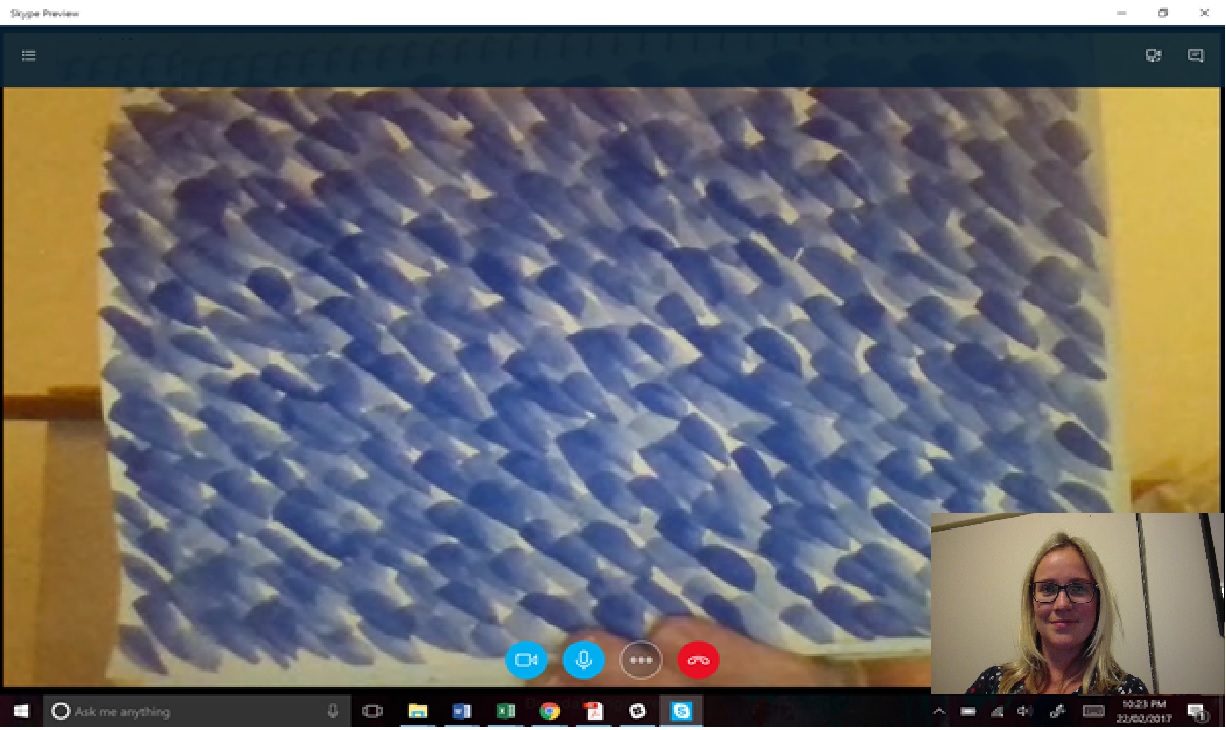
When I first found out that you could to art therapy online I was slightly sceptical. How could it possibly be the same when you’re not in the room together? Wouldn’t it be awkward to talk via video?
I decided to try it out for myself, booking an online session with another art therapist. I wanted to know what it was like for clients so I could relate to how it felt on the other end of the video call and create the best experience.
The art therapy session went well, I felt comfortable, connected and supported and was able to work through deep material in the first session with someone I have never met in person.
Accessible Art Therapy
Eventually, I decided I wanted to offer art therapy online myself, to reach people outside Perth who can’t get to the office. During the isolating 4 years I worked fly-in, fly-out it was hard to get support while you were on site and to fit in appointments on days back in town. With an internet connection you aren’t limited to the services in your local area.
To prepare to launch online art therapy I completed many practice sessions with clients all around Australia and overseas. Adapting art activities to the materials they had on hand, getting comfortable with Skype, and coping with temperamental internet connections. From their generous feedback I improved the process, making it easier to book appointments across time zones.
I enjoyed being able to express what I was feeling through art, even though I am the very least artistically gifted being on the planet (and that includes animals, insects, birds, etc!).
I’d recommend it to people that are open to trying new things and exploring different ways to tackle a problem that they have ruminated on for long enough (or too long). It helps people to get past that “sticky” point and get beneath any unintentional mental blocks in the process.
I really enjoyed the whole process. Having had therapy in the past, I was surprised at how quickly drawing was able to open up some pretty deep patterns in my life. It felt like a fast track way of uncovering layers.
It’s an easy way to reveal what’s hidden in the subconscious immediately without having to talk about all the details of the issue. Able to obtain lots of insights from really simple expressions of art. No need for any art experience to get results. Really relaxed atmosphere and possibly easier to talk when relating it to a picture rather than the issue itself.
Get in touch to book your online art therapy session
Colouring Books: Gateway to Art Therapy?
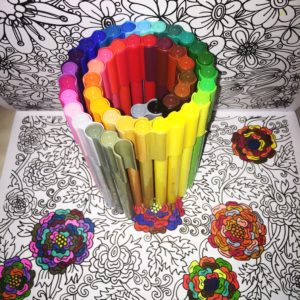
So many unfinished colouring pages
Colouring books flooded into bookstores a few years ago, growing from 1 to 12 millions sales between 2014 and 2015 (in the US alone). Although books are starting to trickle onto sales tables, interest remains stable, representing a worldwide desire to take time out for creativity.
Critics dismiss colouring as a fad, a childish hobby indulged by grown-ups, and superficial wellness that has no relation to the deeper work of art therapy.
But I see nothing wrong with returning to childhood fun, play is just as important for adults.
No one argues that colouring is for everyone, or that colouring in books are a substitute for solving the sources of stress.
It’s ok to try colouring, and stick with it or move on to other hobbies when you’re ready. Colouring might be an accessible way to get into art and art therapy.
Picking up a paintbrush or pencil can be intimidating as an adult, especially after receiving messages that art is only for the talented. Where do you start? I call it ‘blank canvas syndrome’ – where you don’t know what to make and you sit there with your fancy new art materials, too scared to begin making a mark on the white page.
Colouring books solve this problem by giving structure to help you get started and keep going.
Once comfortable with that structure, I have a few ideas on how you can challenge yourself beyond colouring in. I’ll show how you can introduce more elements of free expression and what benefits this brings.
Beyond Colouring – Creative Outlets to Try
Starting with the support of colouring books then breaking out of the lines to free expression is a lesson that mirrors life.
Colouring

Do you colour in the lines?
Not as prescriptive as paint-by-numbers, books or mandala templates allow creative expression through the choice of colour. Avoiding distractions to focus on the colouring task builds mindful concentration. Perfectionists can struggle with needing to neatly colour between the lines, eventually learning to enjoy the process as much as the finished product.
Doodling
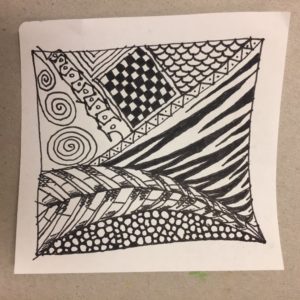
Zentangle structured patterns
Doodling also cops criticism as merely ‘the scribbling done on notes during boring meetings’ which sounds valuable to me! Doodling is a little less structured than colouring because you are creating the lines yourself, but you can make use of step-by-step approaches and doodle libraries such as Zentangling (drawing structured patterns). For examples of how far you can go with doodling, check out artonthefridge which started as a personal challenge to create a drawing a day.
Mandala

Computer generated mandala
Mandalas are decorative circles created as artistic representations of the self. Symmetric patterns that radiate from the centre are usually created in the circle but organic shapes are also used. The mandala creation process is an aid to meditation, and reflecting on the contents is a technique for gaining insights into the self. Many guides exist for drawing intricate patterns or you could play with this generator, print out your design and colour it in.
Art Journal Prompts
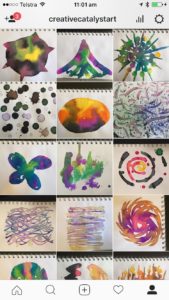
Liquid watercolour 30-day challenge
Now you’re getting into the habit of taking the time to create art, consider getting an art journal to keep your works and track them over time. Art journal challenges are often set up for people to follow and post pictures on Instagram. The art journal prompts mean you’re not stuck on what to do, you can use other posts as inspiration but you still have the choice in how to interpret it (and whether you want to share online or to keep private). Committing to a month-long challenge is less daunting than keeping up with a daily practice. Themes range from skill development (practice art technique) to self-awareness (reflective questions).
Free Art Journaling
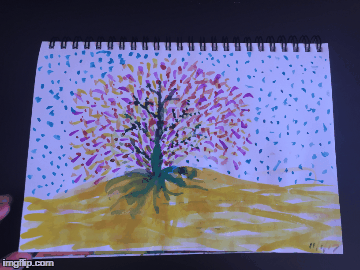
How was your day?
What do I feel like creating today? After gradually building up your comfort in self-expression, you’re ready for a daily art journal. Change it up, test new materials instead of getting stuck in a rut. Long term art journaling allows you to notice changes over time and recurrent themes.
Where is the art therapy?
Whilst these activities don’t involve the art therapy process that you would have with a therapist, they include increasing therapeutic elements. There is an incidental therapeutic value from making art. By adding in elements of self-expression, you are learning to be comfortable using art as an outlet and to communicate your experience. Reflecting on what has been created or choosing topics to explore that concern self-reflection can lead to increased self-awareness.
For more ideas on how to use art as a reflective tool, the ARTLABs show example processes.
Art Therapy for Chronic Pain

Pain Alarm
Recently I was invited to LifeCare Applecross Physiotherapy to talk about using art therapy to treat chronic pain. Learning to understand, cope and manage physical pain drew many parallels to emotional pain. As I discovered, the way we explain our pain affects how we experience it. I happily pay my money for massages despite a few challenging ouch moments, yet I would react with shock and concern if a stranger unexpectedly poked me in the shoulder.
We can think of pain signals as helpful warning signs telling us not to push our bodies to breaking point. But what if the alarm system is broken? Maybe the problem has been fixed, but the alarm is still on, telling us to take care. Or the alarm is stuck and it shouldn’t be on at all. Having a false alarm ringing in your ears all day and night is one way to imagine chronic pain.
Drawing a picture of pain in my body has been helpful to describe to other people what I am feeling. A jagged red and orange line across my shoulders and neck tells the massage therapist what to focus on. Reflecting on where the tension line came from helps me figure out what I can do to solve the root problem, as I am empowered to take the pressure off.
What is Chronic Pain?
When we experience physical pain we hope it will go away after receiving medical treatment or the injury heals. Usually it does, but for some people the pain continues despite no longer having a physical source. One in three Australians live with chronic pain, often also experiencing depression, anxiety or anger, and coping with loss and hardship associated with reduced capacity.
Everyone’s experience of pain is different, the complex interplay between the nervous system and individual factors mean that managing chronic pain is tailored to the needs of each person.
Art Therapy for Chronic Pain
Effective treatments for chronic pain include psychological approaches, which have been adapted to use art materials. Art therapy is being used to treat the psychological aspects of chronic pain and alleviate physical symptoms (Angheluta & Lee, 2011). Typical activities include mindfulness based art therapy, artistic expressions of the pain experience, exploring underlying pain themes identified in art, and reflecting on how to move forward (O’Neill & Moss, 2015).
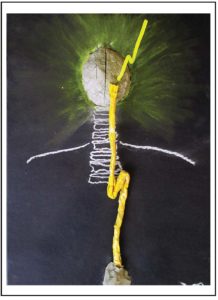
Three-Dimensional Symbol to Represent Pain (O’Neill & Moss, 2015)
How Does Art Therapy Help?
Diversion and Relaxation
Arts and art therapy, particularly when combined with mindfulness can be a relaxing experience, remove the focus from pain and teach techniques for temporary relief.
Holistic Care
Holistic approaches broaden the focus of treatment from the physical source of pain to the impacts on the whole person. People with chronic pain may experience depression, anxiety and anger or be coping with feelings of loss, identity change and hardship as a result of reduced capacity. Art therapy can serve as an outlet for emotions or a way to process changes that affect daily life or future opportunities.
Coping and Self-Management
Beyond giving pain a rating out of ten, people with chronic pain can communicate their experience of pain through art, to feel understood and help direct treatment to where it is needed. By visually exploring pain experience in relation to life events, it’s possible to start to see patterns in what triggers the pain and what actions help with coping. Art is a creative medium where you get to choose what to change in the picture, an empowering approach that builds a sense of self-confidence in managing pain.
Trauma
Physical pain can be connected to unresolved psychological trauma which can be explored and processed in art therapy.

Body Scan Art Response: Symbolising Tension (Orange) and Pain (Red)
Limitations
Artistic ability is not needed to do art therapy, but you need to be open to trying creative expression activities. Art therapy can also bring issues to the surface so you need to feel ready and supported to work through what comes up.
The sensory qualities (odours, feel) of some materials can be overwhelming (e.g. migraine sensitivity) so material choice is tailored to the preferences of each person.
Creative Catalyst Art Therapy
Contact or book a call if you would like to discuss whether art therapy for chronic pain is right for you or your clients.
References
Angheluta, A., & Lee, B. (2011). Art therapy for chronic pain: Applications and future directions. Canadian Journal of Counselling and Psychotherapy / Revue canadienne de counseling et de psychothérapie, 45(2). Retrieved from http://cjc-rcc.ucalgary.ca/cjc/index.php/rcc/article/view/948
Chronic Pain Australia (2017). Chronic Pain Australia. Chronicpainaustralia.org.au.
O’Neill, A. & Moss, H. (2015). A community art therapy group for adults with chronic pain. Art Therapy, 32(4), 158-167. http://dx.doi.org/10.1080/07421656.2015.1091642
November Newsletter 2016


Hello, I’m Lauren Amos – welcome to the October Creative Catalyst newsletter.
Creative Catalyst Art Therapy and Consulting offers art therapy to individuals and groups, and facilitates creative workshops for process improvement and cultural change within organisations.
In this newsletter you’ll find information on public workshops and upcoming programs.
Perth Creative Art Therapy Group
Now reaching over 500 members on Meetup.com, the Perth Creative Art Therapy Group was created so that anyone curious about art therapy could come along to a group session and give it a go.
“I came in not knowing what to expect and really enjoyed it. Also was surprised at how much I got out of it, very insightful.” – workshop participant
Since August we’ve tackled personal development issues such as dealing with the inner critic, the wisdom of your inner mentor, mindfulness, exploring life direction, setting boundaries, coping with change, and self-appreciation. The Sunday afternoon workshops will continue in 2017, and a new Monday night group has started focussing on coping with emotions.
Coping with Emotions: Monday Night Group

Between stimulus and response there is a space. In that space is our power to choose our response. In our response lies our growth and our freedom.
– Viktor E. Frankl
The Monday night group uses expressive art as an outlet for emotions, to develop self-awareness and generate creative strategies to cope.
Instead of being overwhelmed by emotions, we can start to see them as useful signals guiding us to meet our needs. By reflecting on the art, we can identify and process emotions, and learn to understand others. Emotional intelligence is an asset in the workplace and an important life skill.
“I felt comfortable with the group … It’s helping” – workshop participant
Career Directions Package
Are you sure you are in the right job? Do you wake up excited to begin a day of work, knowing that you’re sharing your gifts with the world in line with your values?
If you’re feeling lost in your career you’re not alone. Only a quarter of us are engaged at work and Australians are expected to have 5 separate careers in their lifetimes, leaving us wondering whether to stay or go, and if we go, where and how?
The Career Directions package will be launched early in 2017, a series of one-on-one creative coaching sessions tailored to your goals. Instead of filling out a computer questionnaire that puts you in a box, this package will tap in to your passions, values, and dreams to create your own career path.
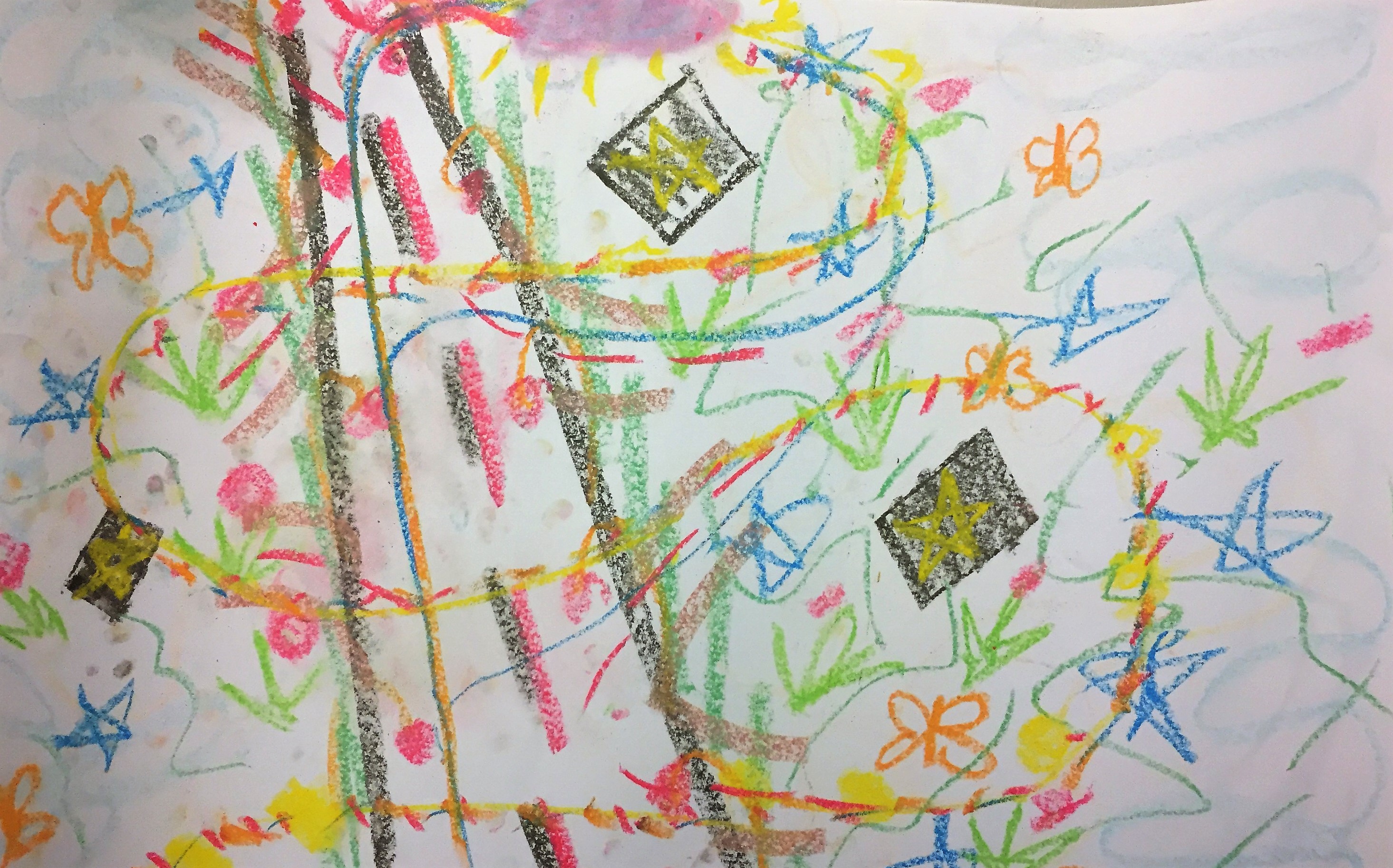
Could your career path use some clarity?
Mental Health Perth Collaboration

Christine Blickensdorf
Creative Catalyst has partnered with Mental Health Perth to offer a series of combined workshops covering creative, mindful and healthy strategies to manage your inner health.
Christine Blickensdorf, director of Mental Health Perth, works with the community to provide in-person support and connection with others living with mental illness. An Art Therapy & Mindfulness workshop was held in November, with more events to be announced in the new year.
November Events
Perth Creative Art Therapy Group:
Sundays: Inner Mentor, Inner critic
Mondays: Coping with Emotions
Mental Health Perth collaboration:
Art Therapy & Mindfulness
Upcoming EventsOnly a few events are held in busy December before Creative Catalyst closes over the new year. The public workshops will be back in January, suggestions for topics are welcome.
Perth Creative Art Therapy Group meets for December will be on:
|
November has been busy with many public workshops and developing programs which I am looking forward to telling you more about when they launch soon.
Have a wonderful December and see you in the new year.
Lauren Amos
October Newsletter 2016


Hello, I’m Lauren Amos – welcome to the October Creative Catalyst newsletter.
Creative Catalyst Art Therapy and Consulting offers art therapy to individuals and groups, and facilitates creative workshops for process improvement and cultural change within organisations.
In this newsletter you’ll find information on the new office, Creative Catalyst events held in October and upcoming events open to the public.
Organised your end of year function yet?
November is looking busy but Creative Catalyst is open to partnering with organisations for their end of year functions.
If you would like to bring a creative, fun and engaging feature to your event, get in touch via contact@laurenamos.com to discuss your needs.
Creative Catalyst can develop and facilitate ice-breaker, team-building, wellness and self-awareness themed activities tailored to your group.
Mount Lawley Office Officially Opened
Creative Catalyst has settled in to the office at 175 Walcott St, Mount Lawley. The space has enough room for workshops with 12 people and will continue to be the home for Perth Creative Art Therapy Group, along with a few collaborative events to be announced.
Individual art therapy sessions are now available for 1 or 1.5 hours, which use a greater range of art materials kept in the permanent office. Longer sessions allow more time to create artworks and get deep into the process of finding insights and solutions.
The travel art therapy service is still available on request.
Creative Catalyst is accepting new clients for art therapy, sessions are available Monday to Thursday afternoons. After work (5pm) appointments can be made on Monday evenings. To find out whether art therapy is right for you and to make a new appointment, please schedule a call.

Inside the new Mount Lawley office, figurines and art materials waiting to play!
Mental Health Community Outreach with Willetton 777 Chemist
In October, Creative Catalyst partnered with 777 Chemist in Willetton to raise awareness during Mental Health Week. Did you know, Perth researcher Dr. Christina Davies completed a study showing that 2 hours per week of arts engagement is linked with improved mental well-being? Painting, drawing, colouring, singing or watching a performance, and going to a gallery all count. Creative outlets for managing stress and coping with emotions are free of side effects and often good fun!
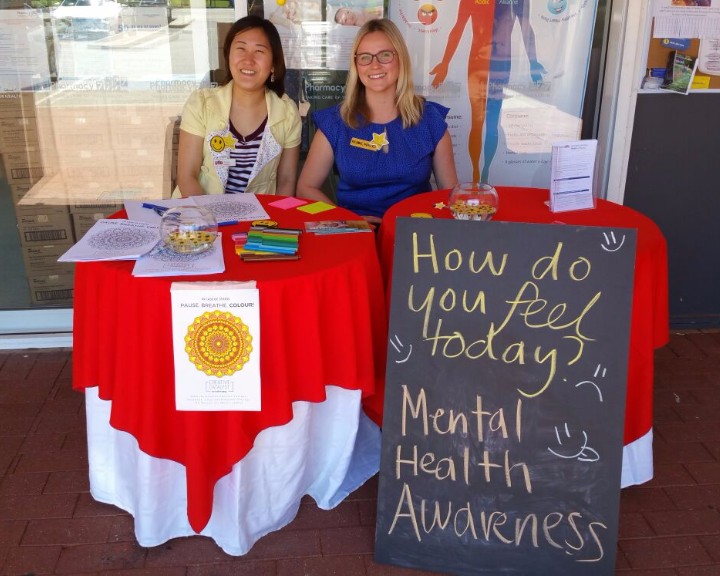
Mental Health Week, outside 777 Chemist Willetton with pharmacist Ai Lian Lee. We spent the day asking people how they were really feeling, chatting about how to manage mental health and handing out colouring-in sheets.
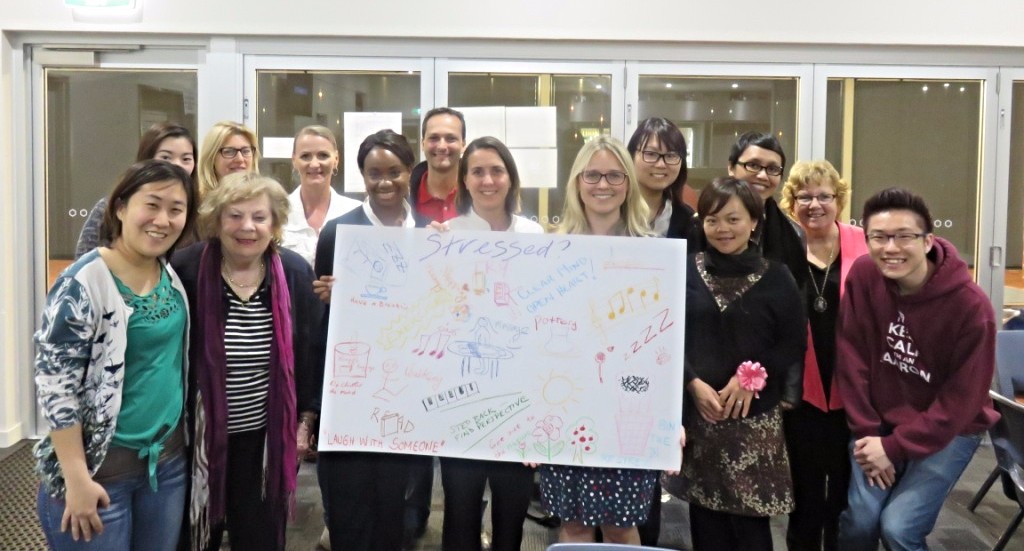
Community event at Willetton Bowling club with 777 Chemist, Willetton. Sharing tips on how to recognise signs of stress, tune in to emotions to find out what we really need, and engaging in stress reduction activities.


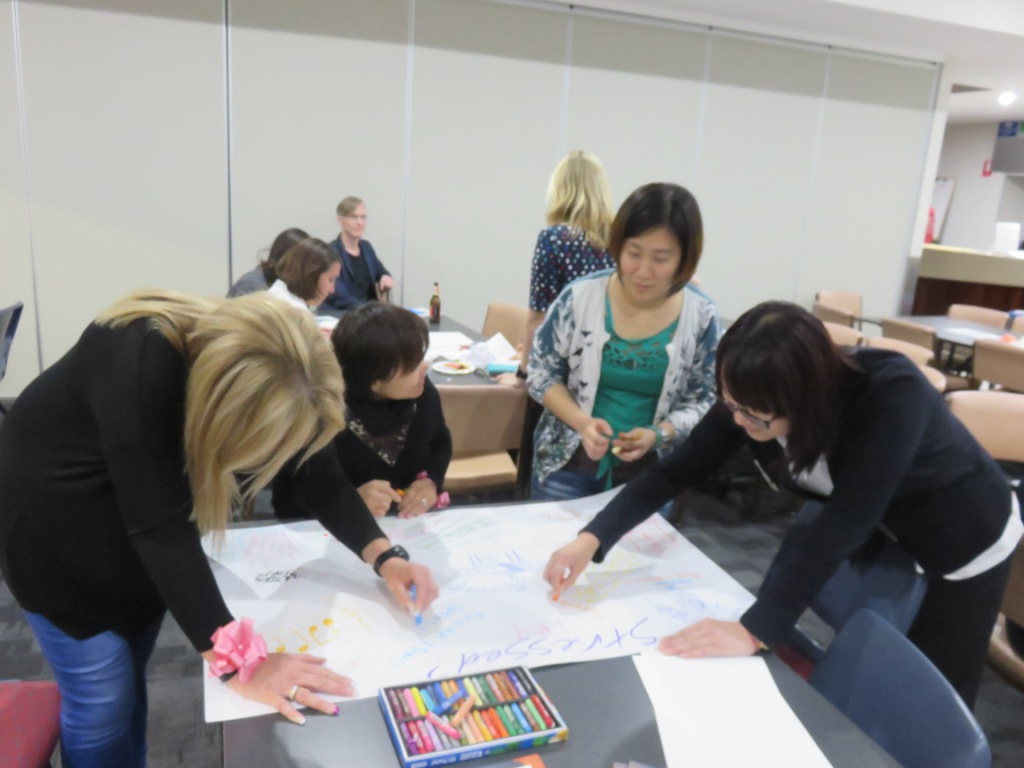
October Events

During October, the Perth Creative Art Therapy Group met for a number of rewarding and inspirational workshops, including:
- Finding Balanced Boundaries to discover where our current boundaries are and explore how to set them to feel secure and at ease.
- Exploring Potential Directions to uncover more details about life paths available and where they lead to get clarity on our direction.
Upcoming EventsPerth Creative Art Therapy Group meets for November will be on:
Creative Catalyst is also teaming up with Mental Health Perth:
|
October was an exciting month for Creative Catalyst, if you are yet to see the new office book in for an appointment or attend one of the November workshops.
Have a wonderful November!
Lauren Amos
Perth Creative Art Therapy Group – September News
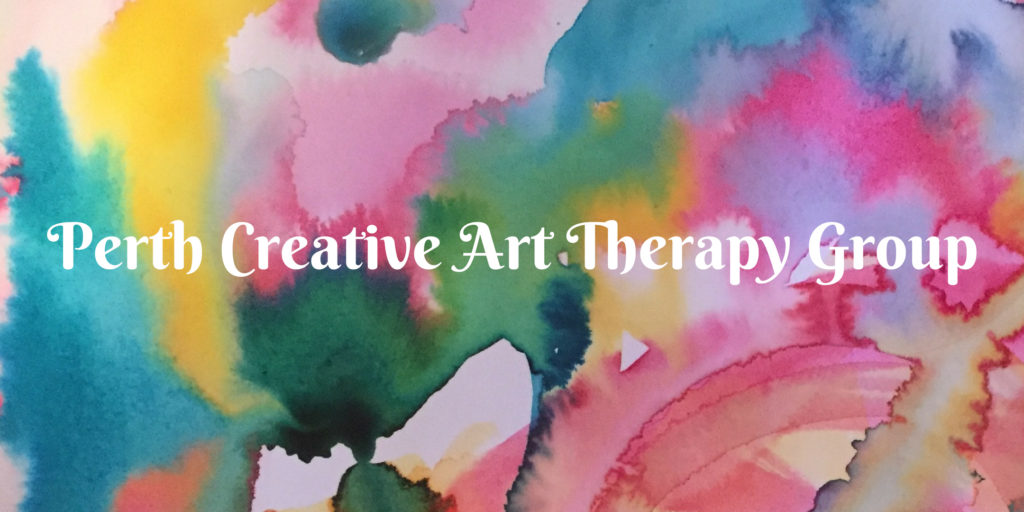
Perth Creative Art Therapy Group: August and September Workshops
Mindfulness Art Therapy: Messages from the Body

Art Therapy: Appreciate & Celebrate
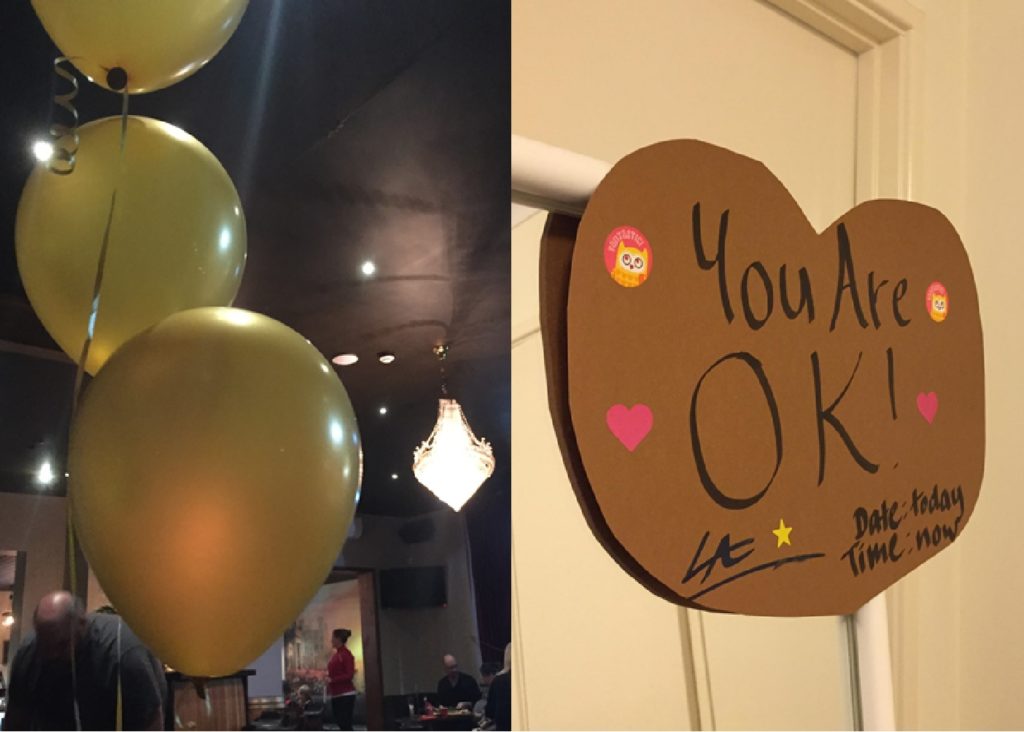
Art Therapy: Transformations – Thriving Through Change
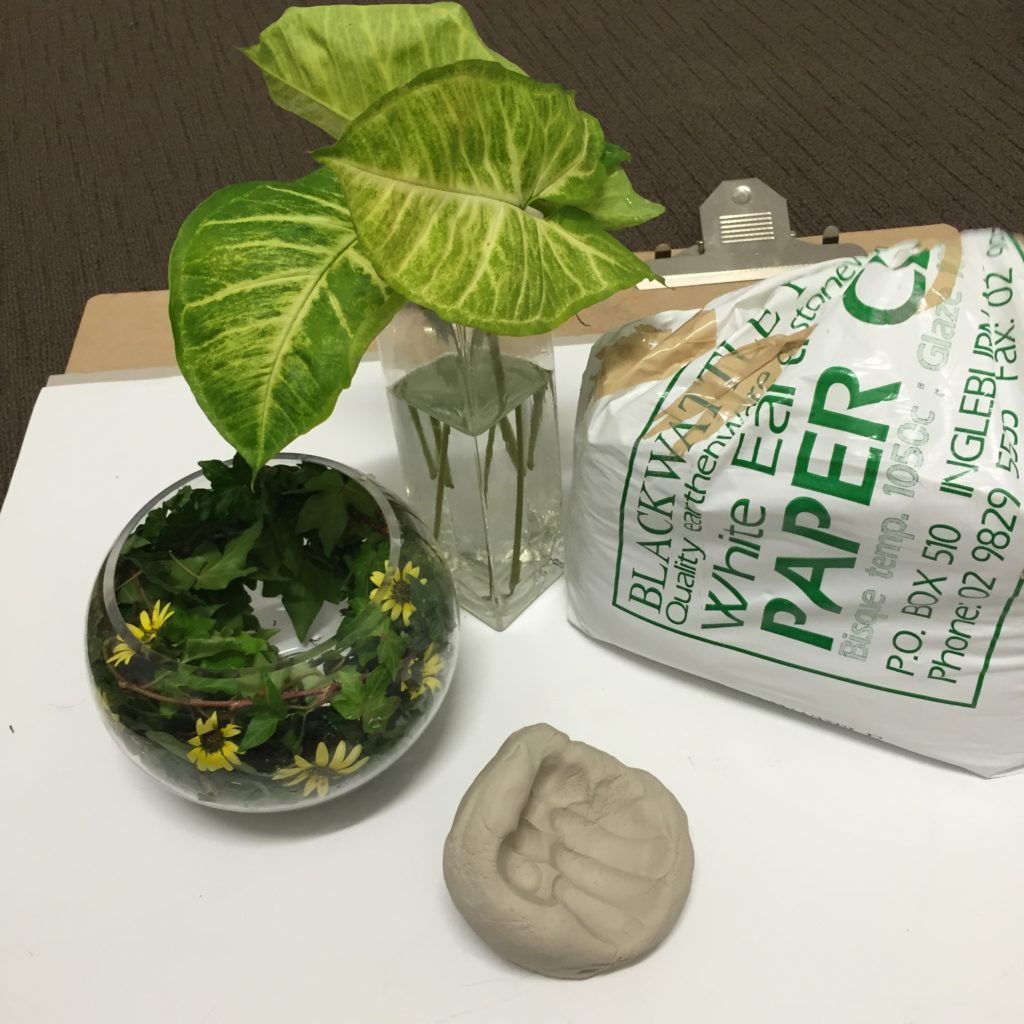
What is an ARTLAB?
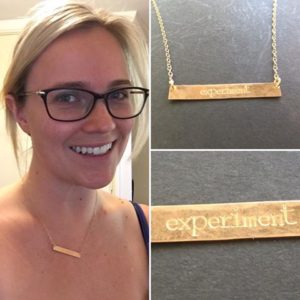
My mantra necklace: ‘experiment’
ARTLABS are creative experiments in self-expression, where I show you my process and suggest how you can try it yourself.
ARTLABs are written up like laboratory reports because they are EXPERIMENTS. In the creative process no outcome can be guaranteed.
There is no failure, only data.
I believe in approaching life with curiosity, as playful experiments that we learn from. We are natural scientists, in that we all have beliefs about the world that we test and revise as we find out more information. Being open to new results stops us from being stuck in past patterns that no longer serve us. I invite you to join the community and share the results of your experiments.
Writing and following an ARTLAB does not require technical scientific knowledge but I will explain the purpose of each section.
ARTLAB
AIM
What is the purpose of this act activity? Art can be fun and healing on its own, but in art therapy it helps to have a focus to direct the process and ensure we are reaching our goals. The aim sets the boundaries and expectations to a manageable size to tackle in the art activity.
MATERIALS
Materials matter. The sensory and emotive qualities of the material affect what can be expressed and processed. Materials are chosen specifically to match the aim as a guide. I will suggest materials and substitutions if some items are rare or expensive. I want you to feel free to use whatever you have on hand, and what feels right to you.
METHOD
You have a focus, materials, you have the space and time, now what do you do with them? I’ll share the steps that I followed to create results so that you can try the process at home.
RESULTS
What did you create? With finished artworks I’ll share a photo as an example, but your results may look entirely different (but be equally meaningful).
In activities that involve continuous art making (such as transforming a lump of clay) you may want to stop occasionally and take a photo for your records, as long as it doesn’t interrupt the process too much. You can compare the photos to remind and compare the stages at the artwork changed.
DISCUSSION
In art therapy, the process of art making is just as important as the artwork itself. But after finishing the artwork I like to take the time to reflect, to see if there are any deeper insights to be gleaned from the activity. I’ll share the discoveries I made about myself or my situation that I found in the art. Sometimes I’ll be curious enough to create additional artworks to explore those insights further.
The themes that emerge from the artwork and lessons learned will differ between people. This is part of the experimental nature, we can’t control what will show up. But whether the result is a deep realisation or simply the catharsis of expression, it is most important what it means to you.
CONCLUSION
In summary, what was learned from the art activity? Where to from now? Sometimes the process answers one question but raises many more, which become the new aims of future experiments.
Try this for yourself and share your insights.
Reflect
For deeper reflection, I might suggest a few reflective questions to ask about the art activity.
February 2017 Newsletter


Hello, I’m Lauren Amos – welcome to the February Creative Catalyst newsletter.
Creative Catalyst Art Therapy and Consulting offers art therapy to individuals and groups, and facilitates creative workshops for process improvement and cultural change within organisations.
In this newsletter you’ll find information on online art therapy and workshops to suit group needs.
Online Art Therapy Launched
 After practising and refining the process with clients around Australia and the world, online art therapy is now available.
After practising and refining the process with clients around Australia and the world, online art therapy is now available.
If you’re outside or Perth of can’t get to the studio, online art therapy is a way to get creative and work through those blocks from the comfort of your own home. Sessions are available across time zones, so if you know someone overseas who might benefit from art therapy feel free to share this with them.
Sessions are 1.5 hours giving you enough time to choose a goal for the session, make art, reflect and discover insights and creatively explore how to achieve your goal. Clients have had success in one session in topics ranging from finding direction (such as in life and career) or visualising and clearing the path towards their personal goals. Even without a clear objective for the session, the art has a way of uncovering what’s really on your mind that you need to work on.
You also don’t need to have a fancy array of art materials to use. Of course it’s nice to have a choice but clients have still gained deep insights from scribbles and stick figures using pencils, pens and whatever can be found on their desks!
More information on the process is on the website, contact if you have more questions or you would like to book a session.
“I’d recommend it to people that are open to trying new things and exploring different ways to tackle a problem that they have ruminated on for long enough (or too long). It helps people to get past that “sticky” point and get beneath any unintentional mental blocks in the process.“ – Skype client
Mindfulness Art Therapy: Messages from the Body
The activity can be adapted to suit the needs of the group:
- Demonstrate art therapy for professional development education
- A non-stigmatising way to initiate conversations around mental health, stress and coping in the workplace
- A refreshing team building exercise
Mindfulness and art therapy activities have been run with diverse groups including:
“Amazing experience, really cool and incredible. It was really an important thing to do to just stop and do this process. Eye opening” – Mindfulness art therapy participant, Spacecubed
“Good exercise that helps visualise how our body is feeling, what signals we receive, help identify the issues and find solutions to fix them. I felt very comfortable sharing my feelings with Lauren and other people in the room.” – Mindfulness art therapy participant, Spacecubed
Check out the guided mindfulness meditation that I recorded to go with the activity.
Creative Catalyst is available to run workshops with private or organisational groups, contact for more information.
Perth Creative Art Therapy Group
The meetup group continues for 2017, in February covering the topics:
- Clearing money blocks
- Motivation
- Reframing
“The art therapy group today provided some insightful prompts that shone a light on my own assumptions and perceptions, as well as on the perceptions we often share through the contributions from other group members. The session was calming, thought-provoking and thoroughly enjoyable. Thank you!” – workshop participant
Upcoming Events
- 6th March, Coping with Emotions
- 12th March, TBA
- 20th March, Coping with Emotions
- 26th March, TBA
After opening the Mount Lawley studio in October, it’s exciting to now offer online services to reach the people of Perth and beyond.
Speaking of the online world, you can also keep in touch with Creative Catalyst via Instagram, the Facebook page and closed Perth Creative Art Therapy Facebook Group.
Wherever you are, I hope your year is humming along brilliantly.
Lauren Amos
January 2017 Newsletter


Hello, I’m Lauren Amos – welcome to the January Creative Catalyst newsletter.
Creative Catalyst Art Therapy and Consulting offers art therapy to individuals and groups, and facilitates creative workshops for process improvement and cultural change within organisations.
In this newsletter you’ll find information on public workshops and online art therapy.
Art Therapy for Pain: Applecross Physio Visit

Pain Alarm
Art therapy is used to cope with emotional pain, but what about physical pain?
This was a question asked by Eddie Tikoft at LifeCare Applecross Physiotherapy. It turns out there is a growing body of research into the use of art therapy for chronic pain. As an outlet or distraction from the pain experience, to cope with the psychological impacts of a chronic condition as well as developing self-awareness around pain triggers to improve self-management.
In January I visited the team of physiotherapists, Pilates instructors and massage therapists to demonstrate art therapy, taking over the consulting area with paper laid out over massage tables as we all drew pictures with oil pastels. The art was used to represent how we were feeling, physically and emotionally, and it was insightful to see the shared experiences among the team (it seems this type of work can be hard on your feet all day!).
The team came away with a greater appreciation of how art therapy worked, I learned a lot about how pain was managed from the physical side and we discuss how a combined approach can help the whole person.
Creative Catalyst is open to educating other organisations on how creative approaches can complement their treatments.
Online Art Therapy via Skype
 One thing I love about opening the Mount Lawley studio is the array of art materials that I can keep for us to play with. But I realise not everyone can make it down for a session in person, maybe you live far away, you’re on a mine site or you are not able to travel.
One thing I love about opening the Mount Lawley studio is the array of art materials that I can keep for us to play with. But I realise not everyone can make it down for a session in person, maybe you live far away, you’re on a mine site or you are not able to travel.When I first heard about art therapy over the internet I was sceptical. Wouldn’t it be a little awkward? How does the art making work? Would it be as effective?
But I had a go as a client as part of my training and found the experience just as powerful as being in the room. I felt connected to the therapist even through the video and I was comfortable working through sensitive topics.
Through January I had many Skype (video chat) based sessions with clients all around Australia and overseas to make sure that the process (and internet connections) worked for everyone. After taking aboard some useful feedback to improve the process (timezones are now handled easily by the booking system) I will be launching online art therapy in February.
Signup to hear more about online art therapy when it launches.
“I really enjoyed the whole process. Having had therapy in the past, I was surprised at how quickly drawing was able to open up some pretty deep patterns in my life. It feels like a fast track way of uncovering layers.” – Skype client
Perth Creative Art Therapy Group
The meetup group is back for 2017 after a few weeks break. January saw an influx of new members interested in starting the new year with creativity.
“First time in a very long time that I have painted. I enjoyed it very much – dealing with emotions from past/present can be difficult and it has definitely helped me with dealing with some personal issues. Thanks.“ – workshop participant
January Events

Perth Creative Art Therapy Group:
Sundays: Letting go, New year new vision
Mondays: Coping with Emotions
Upcoming Events
|
After returning refreshed from holidays, it’s been exciting to pick up momentum again in January and to start planning for the next 12 months.
I hope your year is off to a wonderful start,
Lauren Amos
Messages from the Body: Mindfulness Art Therapy

How are you feeling today?
We don’t always get the chance to check in with how we are going.
Too busy getting on with the job, getting things done, staying focused. Or being stuck in our heads, wonderings about the future, the feelings of other people. It’s important to bring our attention to our bodies occasionally, to make sure we are giving them what they need to support us in achieving our goals.
Mindfulness is a practice of focused attention, a skill that helps us cope with distractions by developing the ability to stay present in the moment.
The body scan is a mindfulness technique that directs attention to the internal sensation of the body, listening and accepting the feelings that we experience.
The idea of sitting down and noticing what you feel inside your body sounds simple, but it can be quite hard. Thoughts keep popping into your head, distracting feelings that you’d rather avoid pop up. And if you’re not used to tuning into feelings inside it can be a challenge to identify what sensations you are having. Listening to a guided mindfulness script can help keep you on track as you follow along with the instructions.
I combined the body scan mindfulness with art therapy to help understand what my body is experiencing, and what it needs.
A while ago I was having a rough week, lots of little aches and pains in my body, a migraine, niggling signals that something wasn’t right but I didn’t know what it was. So I sat myself down to do some mindfulness art therapy to figure out what was going on and sort it out.
ARTLAB
AIM
To find out what my body needs
MATERIALS
A large sheet of paper (A2) you want enough space to capture the details of what you feel through the body.
Crayons, any easy to use set of colours is fine.
METHOD
Find a comfortable place free from interruptions.
Listen to a guided mindfulness body scan, there are many free apps such as Calm, which enables you to choose the length (5 to 10 minutes is recommended for people new to mindfulness). Or, I recorded my own guided mindfulness specifically for this activity which you can listen to below.
Turn the feelings you noticed during the mindfulness activity into a picture, a map of the feelings in your body.
RESULTS
Can you tell how I was feeling from this picture?

DISCUSSION
The body scan mindfulness had a soothing effect as if listening to my body meant it didn’t need to scream at me any more to get my attention.
The major focus of the picture are the tension lines around my neck, shoulders and jaw. I wasn’t able to notice much from the rest of my body because they were getting all the attention.
I took a photo of the picture and booked into a massage therapist, asking her to help fix this problem area. Representing what feelings I had inside allowed me to communicate my needs to someone else.
As well as taking care of the symptoms I reflected upon what had caused these feelings to arise in the first place. At the time I was preparing for a long overseas trip. I was very busy, running around trying to do all the things before I went away, putting a lot of pressure on myself. I reviewed my to-do list and reduced it, removing items that would be too hard to get done properly now and were best left until I returned from my trip.
By linking my body sensations to what was happening in my world, I could change what I was doing to better look after myself.
CONCLUSION
Combining the body scan mindfulness with art therapy was effective in allowing me to hear what my body needed, and think creatively about how I could fix it for myself.
Try this for yourself and share your insights.
Reflect
- What message does my body have for me?
- What could I give myself? Add this to the picture and notice if it changes the feeling in the picture
Online Art Therapy Launched

When I first found out that you could to art therapy online I was slightly sceptical. How could it possibly be the same when you’re not in the room together? Wouldn’t it be awkward to talk via video?
I decided to try it out for myself, booking an online session with another art therapist. I wanted to know what it was like for clients so I could relate to how it felt on the other end of the video call and create the best experience.
The art therapy session went well, I felt comfortable, connected and supported and was able to work through deep material in the first session with someone I have never met in person.
Accessible Art Therapy
Eventually, I decided I wanted to offer art therapy online myself, to reach people outside Perth who can’t get to the office. During the isolating 4 years I worked fly-in, fly-out it was hard to get support while you were on site and to fit in appointments on days back in town. With an internet connection you aren’t limited to the services in your local area.
To prepare to launch online art therapy I completed many practice sessions with clients all around Australia and overseas. Adapting art activities to the materials they had on hand, getting comfortable with Skype, and coping with temperamental internet connections. From their generous feedback I improved the process, making it easier to book appointments across time zones.
I enjoyed being able to express what I was feeling through art, even though I am the very least artistically gifted being on the planet (and that includes animals, insects, birds, etc!).
I’d recommend it to people that are open to trying new things and exploring different ways to tackle a problem that they have ruminated on for long enough (or too long). It helps people to get past that “sticky” point and get beneath any unintentional mental blocks in the process.
I really enjoyed the whole process. Having had therapy in the past, I was surprised at how quickly drawing was able to open up some pretty deep patterns in my life. It felt like a fast track way of uncovering layers.
It’s an easy way to reveal what’s hidden in the subconscious immediately without having to talk about all the details of the issue. Able to obtain lots of insights from really simple expressions of art. No need for any art experience to get results. Really relaxed atmosphere and possibly easier to talk when relating it to a picture rather than the issue itself.
Get in touch to book your online art therapy session
Colouring Books: Gateway to Art Therapy?

So many unfinished colouring pages
Colouring books flooded into bookstores a few years ago, growing from 1 to 12 millions sales between 2014 and 2015 (in the US alone). Although books are starting to trickle onto sales tables, interest remains stable, representing a worldwide desire to take time out for creativity.
Critics dismiss colouring as a fad, a childish hobby indulged by grown-ups, and superficial wellness that has no relation to the deeper work of art therapy.
But I see nothing wrong with returning to childhood fun, play is just as important for adults.
No one argues that colouring is for everyone, or that colouring in books are a substitute for solving the sources of stress.
It’s ok to try colouring, and stick with it or move on to other hobbies when you’re ready. Colouring might be an accessible way to get into art and art therapy.
Picking up a paintbrush or pencil can be intimidating as an adult, especially after receiving messages that art is only for the talented. Where do you start? I call it ‘blank canvas syndrome’ – where you don’t know what to make and you sit there with your fancy new art materials, too scared to begin making a mark on the white page.
Colouring books solve this problem by giving structure to help you get started and keep going.
Once comfortable with that structure, I have a few ideas on how you can challenge yourself beyond colouring in. I’ll show how you can introduce more elements of free expression and what benefits this brings.
Beyond Colouring – Creative Outlets to Try
Starting with the support of colouring books then breaking out of the lines to free expression is a lesson that mirrors life.
Colouring

Do you colour in the lines?
Not as prescriptive as paint-by-numbers, books or mandala templates allow creative expression through the choice of colour. Avoiding distractions to focus on the colouring task builds mindful concentration. Perfectionists can struggle with needing to neatly colour between the lines, eventually learning to enjoy the process as much as the finished product.
Doodling

Zentangle structured patterns
Doodling also cops criticism as merely ‘the scribbling done on notes during boring meetings’ which sounds valuable to me! Doodling is a little less structured than colouring because you are creating the lines yourself, but you can make use of step-by-step approaches and doodle libraries such as Zentangling (drawing structured patterns). For examples of how far you can go with doodling, check out artonthefridge which started as a personal challenge to create a drawing a day.
Mandala

Computer generated mandala
Mandalas are decorative circles created as artistic representations of the self. Symmetric patterns that radiate from the centre are usually created in the circle but organic shapes are also used. The mandala creation process is an aid to meditation, and reflecting on the contents is a technique for gaining insights into the self. Many guides exist for drawing intricate patterns or you could play with this generator, print out your design and colour it in.
Art Journal Prompts

Liquid watercolour 30-day challenge
Now you’re getting into the habit of taking the time to create art, consider getting an art journal to keep your works and track them over time. Art journal challenges are often set up for people to follow and post pictures on Instagram. The art journal prompts mean you’re not stuck on what to do, you can use other posts as inspiration but you still have the choice in how to interpret it (and whether you want to share online or to keep private). Committing to a month-long challenge is less daunting than keeping up with a daily practice. Themes range from skill development (practice art technique) to self-awareness (reflective questions).
Free Art Journaling

How was your day?
What do I feel like creating today? After gradually building up your comfort in self-expression, you’re ready for a daily art journal. Change it up, test new materials instead of getting stuck in a rut. Long term art journaling allows you to notice changes over time and recurrent themes.
Where is the art therapy?
Whilst these activities don’t involve the art therapy process that you would have with a therapist, they include increasing therapeutic elements. There is an incidental therapeutic value from making art. By adding in elements of self-expression, you are learning to be comfortable using art as an outlet and to communicate your experience. Reflecting on what has been created or choosing topics to explore that concern self-reflection can lead to increased self-awareness.
For more ideas on how to use art as a reflective tool, the ARTLABs show example processes.
Art Therapy for Chronic Pain

Pain Alarm
Recently I was invited to LifeCare Applecross Physiotherapy to talk about using art therapy to treat chronic pain. Learning to understand, cope and manage physical pain drew many parallels to emotional pain. As I discovered, the way we explain our pain affects how we experience it. I happily pay my money for massages despite a few challenging ouch moments, yet I would react with shock and concern if a stranger unexpectedly poked me in the shoulder.
We can think of pain signals as helpful warning signs telling us not to push our bodies to breaking point. But what if the alarm system is broken? Maybe the problem has been fixed, but the alarm is still on, telling us to take care. Or the alarm is stuck and it shouldn’t be on at all. Having a false alarm ringing in your ears all day and night is one way to imagine chronic pain.
Drawing a picture of pain in my body has been helpful to describe to other people what I am feeling. A jagged red and orange line across my shoulders and neck tells the massage therapist what to focus on. Reflecting on where the tension line came from helps me figure out what I can do to solve the root problem, as I am empowered to take the pressure off.
What is Chronic Pain?
When we experience physical pain we hope it will go away after receiving medical treatment or the injury heals. Usually it does, but for some people the pain continues despite no longer having a physical source. One in three Australians live with chronic pain, often also experiencing depression, anxiety or anger, and coping with loss and hardship associated with reduced capacity.
Everyone’s experience of pain is different, the complex interplay between the nervous system and individual factors mean that managing chronic pain is tailored to the needs of each person.
Art Therapy for Chronic Pain
Effective treatments for chronic pain include psychological approaches, which have been adapted to use art materials. Art therapy is being used to treat the psychological aspects of chronic pain and alleviate physical symptoms (Angheluta & Lee, 2011). Typical activities include mindfulness based art therapy, artistic expressions of the pain experience, exploring underlying pain themes identified in art, and reflecting on how to move forward (O’Neill & Moss, 2015).

Three-Dimensional Symbol to Represent Pain (O’Neill & Moss, 2015)
How Does Art Therapy Help?
Diversion and Relaxation
Arts and art therapy, particularly when combined with mindfulness can be a relaxing experience, remove the focus from pain and teach techniques for temporary relief.
Holistic Care
Holistic approaches broaden the focus of treatment from the physical source of pain to the impacts on the whole person. People with chronic pain may experience depression, anxiety and anger or be coping with feelings of loss, identity change and hardship as a result of reduced capacity. Art therapy can serve as an outlet for emotions or a way to process changes that affect daily life or future opportunities.
Coping and Self-Management
Beyond giving pain a rating out of ten, people with chronic pain can communicate their experience of pain through art, to feel understood and help direct treatment to where it is needed. By visually exploring pain experience in relation to life events, it’s possible to start to see patterns in what triggers the pain and what actions help with coping. Art is a creative medium where you get to choose what to change in the picture, an empowering approach that builds a sense of self-confidence in managing pain.
Trauma
Physical pain can be connected to unresolved psychological trauma which can be explored and processed in art therapy.

Body Scan Art Response: Symbolising Tension (Orange) and Pain (Red)
Limitations
Artistic ability is not needed to do art therapy, but you need to be open to trying creative expression activities. Art therapy can also bring issues to the surface so you need to feel ready and supported to work through what comes up.
The sensory qualities (odours, feel) of some materials can be overwhelming (e.g. migraine sensitivity) so material choice is tailored to the preferences of each person.
Creative Catalyst Art Therapy
Contact or book a call if you would like to discuss whether art therapy for chronic pain is right for you or your clients.
References
Angheluta, A., & Lee, B. (2011). Art therapy for chronic pain: Applications and future directions. Canadian Journal of Counselling and Psychotherapy / Revue canadienne de counseling et de psychothérapie, 45(2). Retrieved from http://cjc-rcc.ucalgary.ca/cjc/index.php/rcc/article/view/948
Chronic Pain Australia (2017). Chronic Pain Australia. Chronicpainaustralia.org.au.
O’Neill, A. & Moss, H. (2015). A community art therapy group for adults with chronic pain. Art Therapy, 32(4), 158-167. http://dx.doi.org/10.1080/07421656.2015.1091642
November Newsletter 2016


Hello, I’m Lauren Amos – welcome to the October Creative Catalyst newsletter.
Creative Catalyst Art Therapy and Consulting offers art therapy to individuals and groups, and facilitates creative workshops for process improvement and cultural change within organisations.
In this newsletter you’ll find information on public workshops and upcoming programs.
Perth Creative Art Therapy Group
Now reaching over 500 members on Meetup.com, the Perth Creative Art Therapy Group was created so that anyone curious about art therapy could come along to a group session and give it a go.
“I came in not knowing what to expect and really enjoyed it. Also was surprised at how much I got out of it, very insightful.” – workshop participant
Since August we’ve tackled personal development issues such as dealing with the inner critic, the wisdom of your inner mentor, mindfulness, exploring life direction, setting boundaries, coping with change, and self-appreciation. The Sunday afternoon workshops will continue in 2017, and a new Monday night group has started focussing on coping with emotions.
Coping with Emotions: Monday Night Group

Between stimulus and response there is a space. In that space is our power to choose our response. In our response lies our growth and our freedom.
– Viktor E. Frankl
The Monday night group uses expressive art as an outlet for emotions, to develop self-awareness and generate creative strategies to cope.
Instead of being overwhelmed by emotions, we can start to see them as useful signals guiding us to meet our needs. By reflecting on the art, we can identify and process emotions, and learn to understand others. Emotional intelligence is an asset in the workplace and an important life skill.
“I felt comfortable with the group … It’s helping” – workshop participant
Career Directions Package
Are you sure you are in the right job? Do you wake up excited to begin a day of work, knowing that you’re sharing your gifts with the world in line with your values?
If you’re feeling lost in your career you’re not alone. Only a quarter of us are engaged at work and Australians are expected to have 5 separate careers in their lifetimes, leaving us wondering whether to stay or go, and if we go, where and how?
The Career Directions package will be launched early in 2017, a series of one-on-one creative coaching sessions tailored to your goals. Instead of filling out a computer questionnaire that puts you in a box, this package will tap in to your passions, values, and dreams to create your own career path.

Could your career path use some clarity?
Mental Health Perth Collaboration

Christine Blickensdorf
Creative Catalyst has partnered with Mental Health Perth to offer a series of combined workshops covering creative, mindful and healthy strategies to manage your inner health.
Christine Blickensdorf, director of Mental Health Perth, works with the community to provide in-person support and connection with others living with mental illness. An Art Therapy & Mindfulness workshop was held in November, with more events to be announced in the new year.
November Events
Perth Creative Art Therapy Group:
Sundays: Inner Mentor, Inner critic
Mondays: Coping with Emotions
Mental Health Perth collaboration:
Art Therapy & Mindfulness
Upcoming EventsOnly a few events are held in busy December before Creative Catalyst closes over the new year. The public workshops will be back in January, suggestions for topics are welcome.
Perth Creative Art Therapy Group meets for December will be on:
|
November has been busy with many public workshops and developing programs which I am looking forward to telling you more about when they launch soon.
Have a wonderful December and see you in the new year.
Lauren Amos
October Newsletter 2016


Hello, I’m Lauren Amos – welcome to the October Creative Catalyst newsletter.
Creative Catalyst Art Therapy and Consulting offers art therapy to individuals and groups, and facilitates creative workshops for process improvement and cultural change within organisations.
In this newsletter you’ll find information on the new office, Creative Catalyst events held in October and upcoming events open to the public.
Organised your end of year function yet?
November is looking busy but Creative Catalyst is open to partnering with organisations for their end of year functions.
If you would like to bring a creative, fun and engaging feature to your event, get in touch via contact@laurenamos.com to discuss your needs.
Creative Catalyst can develop and facilitate ice-breaker, team-building, wellness and self-awareness themed activities tailored to your group.
Mount Lawley Office Officially Opened
Creative Catalyst has settled in to the office at 175 Walcott St, Mount Lawley. The space has enough room for workshops with 12 people and will continue to be the home for Perth Creative Art Therapy Group, along with a few collaborative events to be announced.
Individual art therapy sessions are now available for 1 or 1.5 hours, which use a greater range of art materials kept in the permanent office. Longer sessions allow more time to create artworks and get deep into the process of finding insights and solutions.
The travel art therapy service is still available on request.
Creative Catalyst is accepting new clients for art therapy, sessions are available Monday to Thursday afternoons. After work (5pm) appointments can be made on Monday evenings. To find out whether art therapy is right for you and to make a new appointment, please schedule a call.

Inside the new Mount Lawley office, figurines and art materials waiting to play!
Mental Health Community Outreach with Willetton 777 Chemist
In October, Creative Catalyst partnered with 777 Chemist in Willetton to raise awareness during Mental Health Week. Did you know, Perth researcher Dr. Christina Davies completed a study showing that 2 hours per week of arts engagement is linked with improved mental well-being? Painting, drawing, colouring, singing or watching a performance, and going to a gallery all count. Creative outlets for managing stress and coping with emotions are free of side effects and often good fun!

Mental Health Week, outside 777 Chemist Willetton with pharmacist Ai Lian Lee. We spent the day asking people how they were really feeling, chatting about how to manage mental health and handing out colouring-in sheets.

Community event at Willetton Bowling club with 777 Chemist, Willetton. Sharing tips on how to recognise signs of stress, tune in to emotions to find out what we really need, and engaging in stress reduction activities.



October Events

During October, the Perth Creative Art Therapy Group met for a number of rewarding and inspirational workshops, including:
- Finding Balanced Boundaries to discover where our current boundaries are and explore how to set them to feel secure and at ease.
- Exploring Potential Directions to uncover more details about life paths available and where they lead to get clarity on our direction.
Upcoming EventsPerth Creative Art Therapy Group meets for November will be on:
Creative Catalyst is also teaming up with Mental Health Perth:
|
October was an exciting month for Creative Catalyst, if you are yet to see the new office book in for an appointment or attend one of the November workshops.
Have a wonderful November!
Lauren Amos
Perth Creative Art Therapy Group – September News

Perth Creative Art Therapy Group: August and September Workshops
Mindfulness Art Therapy: Messages from the Body

Art Therapy: Appreciate & Celebrate

Art Therapy: Transformations – Thriving Through Change

What is an ARTLAB?

My mantra necklace: ‘experiment’
ARTLABS are creative experiments in self-expression, where I show you my process and suggest how you can try it yourself.
ARTLABs are written up like laboratory reports because they are EXPERIMENTS. In the creative process no outcome can be guaranteed.
There is no failure, only data.
I believe in approaching life with curiosity, as playful experiments that we learn from. We are natural scientists, in that we all have beliefs about the world that we test and revise as we find out more information. Being open to new results stops us from being stuck in past patterns that no longer serve us. I invite you to join the community and share the results of your experiments.
Writing and following an ARTLAB does not require technical scientific knowledge but I will explain the purpose of each section.
ARTLAB
AIM
What is the purpose of this act activity? Art can be fun and healing on its own, but in art therapy it helps to have a focus to direct the process and ensure we are reaching our goals. The aim sets the boundaries and expectations to a manageable size to tackle in the art activity.
MATERIALS
Materials matter. The sensory and emotive qualities of the material affect what can be expressed and processed. Materials are chosen specifically to match the aim as a guide. I will suggest materials and substitutions if some items are rare or expensive. I want you to feel free to use whatever you have on hand, and what feels right to you.
METHOD
You have a focus, materials, you have the space and time, now what do you do with them? I’ll share the steps that I followed to create results so that you can try the process at home.
RESULTS
What did you create? With finished artworks I’ll share a photo as an example, but your results may look entirely different (but be equally meaningful).
In activities that involve continuous art making (such as transforming a lump of clay) you may want to stop occasionally and take a photo for your records, as long as it doesn’t interrupt the process too much. You can compare the photos to remind and compare the stages at the artwork changed.
DISCUSSION
In art therapy, the process of art making is just as important as the artwork itself. But after finishing the artwork I like to take the time to reflect, to see if there are any deeper insights to be gleaned from the activity. I’ll share the discoveries I made about myself or my situation that I found in the art. Sometimes I’ll be curious enough to create additional artworks to explore those insights further.
The themes that emerge from the artwork and lessons learned will differ between people. This is part of the experimental nature, we can’t control what will show up. But whether the result is a deep realisation or simply the catharsis of expression, it is most important what it means to you.
CONCLUSION
In summary, what was learned from the art activity? Where to from now? Sometimes the process answers one question but raises many more, which become the new aims of future experiments.
Try this for yourself and share your insights.
Reflect
For deeper reflection, I might suggest a few reflective questions to ask about the art activity.

Hi! I’m Lauren. A Chemical Engineer turned Art Therapist now helping people and organisations transform.